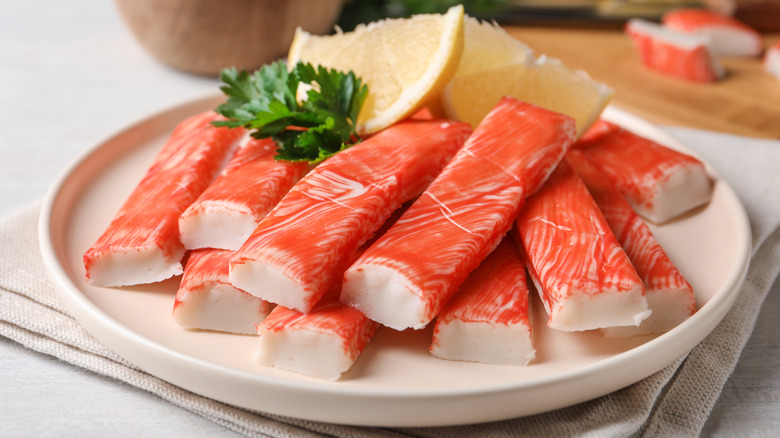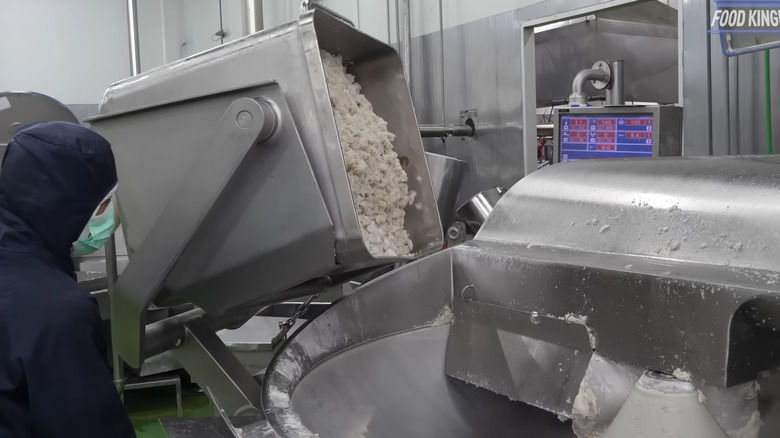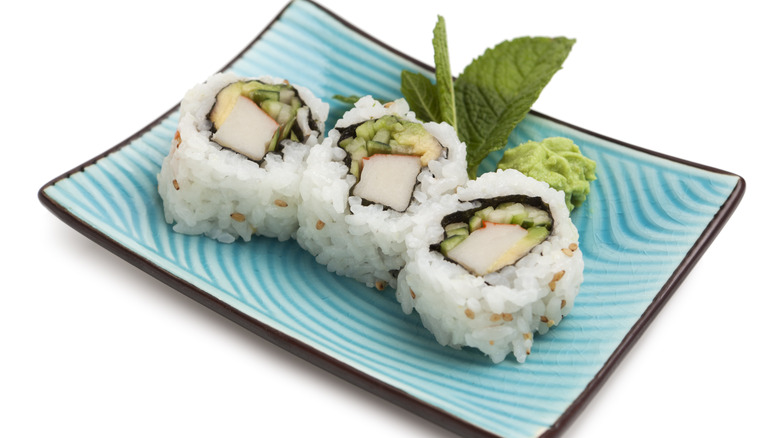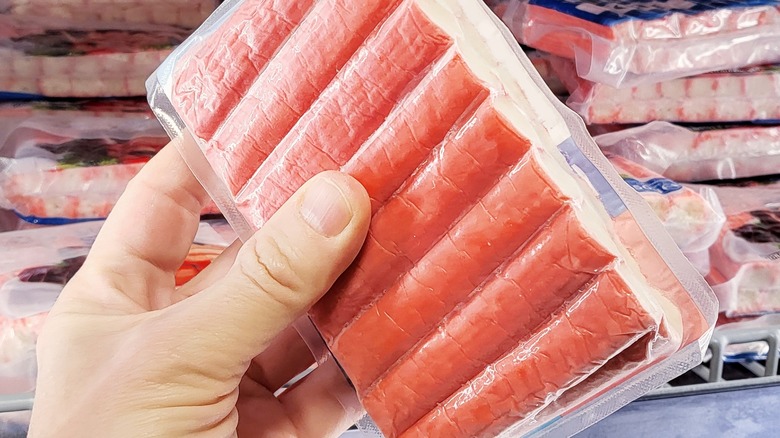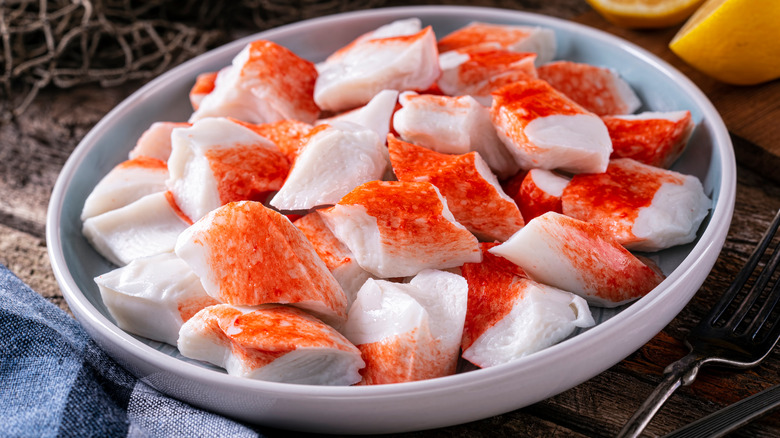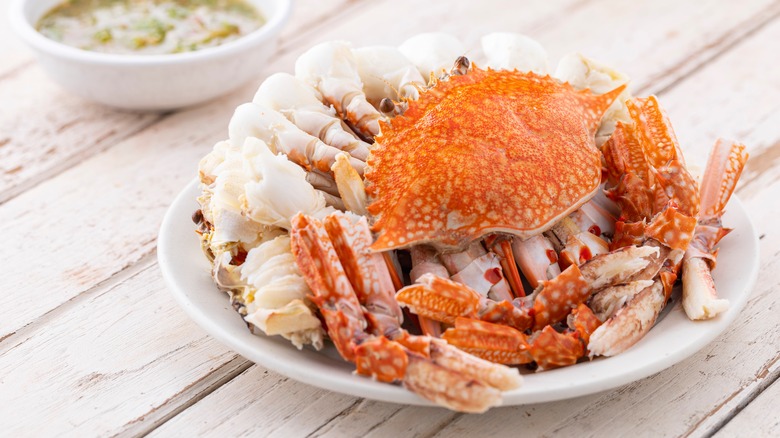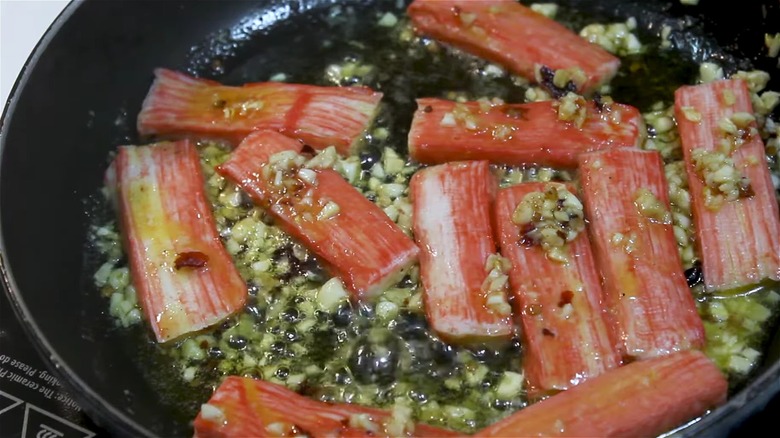7 Of The Biggest Imitation Crab Myths Debunked
Any food with the term "imitation" in the name is sure to lead to some confusion. Usually, this results in the public asking what the imitation food is actually made of. This is one of many questions that plagues imitation crab, a food that's been consumed in the United States since the 1970s. Unsurprisingly, several myths have arisen concerning what ingredients are used to make imitation crab. Further myths, regarding how the product is made and how cooks use it, also abound.
Many of these myths put prospective consumers off imitation crab — which is otherwise known as surimi — potentially limiting their enjoyment of this cheap protein. What's more, they limit the ability of America's public and its food businesses to take full advantage of imitation crab's growing global market at a time when domestic crab supplies are becoming increasingly tenuous. As such, we have taken it upon ourselves to debunk seven of the biggest myths surrounding imitation crab, providing you with the requisite knowledge to understand this oft-derided food.
1. Myth: It doesn't contain any seafood
Given its status as an imitation food, many Americans believe that imitation crab contains no seafood at all. This is incorrect; imitation crab's primary ingredient is actually fish. While the type of fish that's used varies depending on where it is produced, white fish meat is always preferred. In the United States, fresh Alaska pollock — the same species that's used to make McDonald's Filet-O-Fish — is particularly popular because it is naturally abundant, easy to process, and carries minimal flavor. All these characteristics are perfect for producing imitation crab at a large scale.
Aside from the fish, the production of imitation crab uses other seafood ingredients, including natural flavor compounds derived from crabs. Some imitation crab products even blend Alaska pollock with the meat of shellfish species including crab and lobster, although the percentage of shellfish meat used is usually small.
Imitation crab does contain several ingredients that are not derived from seafood, including egg whites, sugar, and starches. Artificial flavors and colorings are also used by some suppliers to achieve the desired appearance and taste. However, others manage with natural ingredients alone, using the likes of paprika as a natural food coloring.
2. Myth: It's only used in sushi
Imitation crab has many culinary uses. Among the most popular is using it as a filling for California rolls and derivative recipes such as California roll lettuce cups. Imitation crab is used in these instances because it is a much cheaper alternative to real crab meat and satisfactorily performs the same role. Nowadays, all but the most luxurious California rolls use imitation crab as a filling, and this ubiquity has caused many Americans to associate the product with sushi alone. This is a mistake, as imitation crab is actually used to make a huge variety of dishes.
Imitation crab's versatility was highlighted by chef and Food Network star Nancy Fuller. In an interview with Genuine Alaska Pollock Producers, Fuller recalled, "In 1974 I started using Surimi in a recipe I called 'crab dip' ... I would keep back a small batch to stuff fish, bake pasta, mix to scrambled eggs or add to fresh vegetables. Surimi is one of the most versatile proteins I worked with." Other culinary uses for surimi include using it to make kani salad and even enjoying imitation crab in sandwiches alongside tuna. What's more, many grocery store crab salads are made with an imitation crab mixture.
3. Myth: Imitation crab has a short history
As imitation crab was only distributed across the United States during the late 20th century, many Americans believe it is a food product that came about relatively recently. However, imitation crab has a centuries-long history, as it stems from the Japanese tradition of making surimi.
Surimi was created in Japan as a means to preserve leftover seafood by grinding fish with salt. This mixture was — and is — used to create dishes such as chikuwa, wherein surimi is wrapped around bamboo sticks before being steamed. Another traditional, popular, surimi-based dish is satsuma-age, which is made by frying discs of surimi in oil.
Surimi was first transformed into imitation crab during the early 1970s, when scientists discovered that adding sugars allowed the surimi to be frozen without losing its properties. This allowed production and distribution of surimi products, including imitation crab, to be completed on an industrial, global scale.
4. Myth: There's only one type of imitation crab
When speaking to Vice, a flavorist called Matthieu explained how varied surimi can be, saying, "In Japan, there are a lot of different types of surimi. What differentiates them is how they're cooked. Some are steamed, others are cooked in the oven, boiled or fried. It gives them different textures."
Imitation crab can also be differentiated by the form it is shaped into. There are two main options: flakes and sticks. Of these, flakes tend to be denser and are best used in baked dishes such as imitation crab macaroni and cheese. Crab sticks have a looser, more stringy texture and are seen as being more versatile than flakes.
Of course, imitation crab can also be distinguished by brand. Due to differing ingredient lists and processing methods, each company produces a slightly different type of imitation crab. Trying various styles and brands is the only way to find which imitation crab suits your tastes and needs best.
5. Myth: It's got a similar nutritional profile to crab
Given that it is used as a substitute for real crab meat, some Americans assume imitation crab boasts a similar nutritional profile. This is not the case, with imitation crab containing much less protein than regular crab meat. In fact, per 100-gram serving, imitation crab contains around 10 fewer grams of protein than cooked crab meat. Imitation crab also has slightly less sodium than cooked crab meat and contains much lower amounts of micronutrients, including an array of vitamins and minerals.
Given that starch forms a key ingredient in imitation crab, it's not surprising that the product contains a great deal more carbohydrates than crab meat. Each 100-gram serving of imitation crab contains around 16 grams of carbohydrates, whereas cooked crab meat contains none. As an important aside, this means imitation grab is not suitable for those with gluten intolerances.
6. Myth: Imitation crab is unsustainable
Given that imitation crab is a highly processed food, some consumers believe it is more sustainable to eat fresh, locally caught crab. While this can be the case, many of America's crab fisheries are severely depleted, with some having collapsed completely with catastrophic consequences. For example, some 10 billion snow crabs have been lost from the Bering Sea fishery.
Rather than overfishing, climate change has been suggested as the key driver of these collapses. As Professor Christopher Harley explained to New Scientist, "There have been a number of big population crashes in marine species due to overfishing. We are now witnessing more and more big crashes associated with extreme temperatures." Buying alternatives to crab, such as imitation crab, alleviates pressure on these decimated fisheries and gives them a greater chance of regeneration.
Thankfully, the stocks of Alaska pollock, which most of the imitation crab sold in the United States is made from, are extremely robust. It is one of the largest fisheries on the planet and is not currently overfished. What's more, bycatch (accidentally netting other species) is notably low, standing below 1%. All of this makes imitation crab a much more sustainable option then many currently believe.
7. Myth: It requires thorough cooking
A classic mistake that people make when first using imitation crab is to cook it thoroughly. People often do this because they believe it is a raw product. In reality, imitation crab is always cooked during the production process, usually via steaming. This means the product only requires heating or defrosting before it is consumed. Anything more, and the imitation crab becomes overcooked.
There are many ways of heating up imitation crab without overcooking it. One of the most popular methods is to put imitation crab sticks in a microwave for approximately 30 seconds. Those without a microwave can opt to use the oven, although it is advised to place the imitation crab in a water-filled pan to prevent it from drying out. Other methods of heating abound, including steaming for three to five minutes or sautéing. For this latter method, smaller pieces of imitation crab are preferred, as they heat up much quicker than their larger counterparts.
